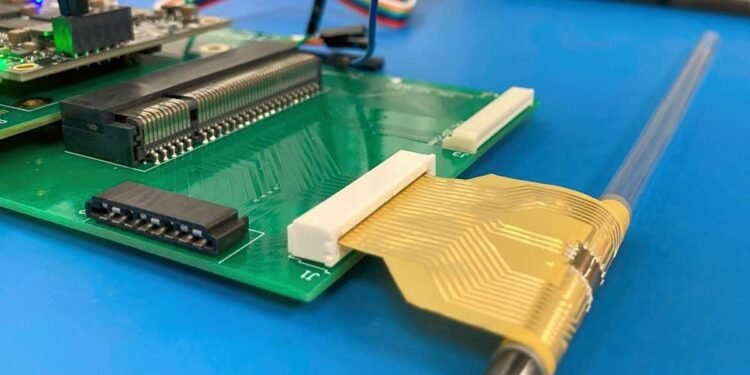For the first time, scientists have created a flexible programmable chip that is not made of silicon. The new ultralow-power 32-bit microprocessor from U.K.-based Pragmatic Semiconductor and its colleagues can operate while bent, and can run machine learning workloads. The microchip’s open-source RISC-V architecture suggests it might cost less than a dollar, putting it in a position to power wearable healthcare electronics, smart package labels, and other inexpensive items, its inventors add.
For example, “we can develop an ECG patch that has flexible electrodes attached to the chest and a flexible microprocessor connected to flexible electrodes to classify arrhythmia conditions by processing the ECG data from a patient,” says Emre Ozer, senior director of processor development at Pragmantic, a flexible chip manufacturer in Cambridge, England. Detecting normal heart rhythms versus an arrhythmia “is a machine learning task that can run in software in the flexible microprocessor,” he says.
Flexible electronics have the potential for any application requiring interactions with soft materials, such as devices worn on or implanted within the body. Those applications could include on-skin computers, soft robotics, and brain-machine interfaces. But, conventional electronics are made of rigid materials such as silicon.
Open-source, Flexible, and Fast Enough
Pragmatic sought to create a flexible microchip that cost significantly less to make than a silicon processor. The new device, named Flex-RV, is a 32-bit microprocessor based on the metal-oxide semiconductor indium gallium zinc oxide (IGZO).
Attempts to create flexible devices from silicon require special packaging for the brittle microchips to protect them from the mechanical stresses of bending and stretching. In contrast, pliable thin-film transistors made from IGZO can be made directly at low temperatures onto flexible plastics, leading to lower costs.
The new microchip is based on the RISC-V instruction set. (RISC stands for reduced instruction set computer.) First introduced in 2010, RISC-V aims to enable smaller, lower-power, better-performing processors by slimming down the core set of instructions they can execute.
“Our end goal is to democratize computing by developing a license-free microprocessor,” Ozer says.
RISC-V’s is both free and open-source, letting chip designer dodge the costly licensing fees associated with proprietary architectures such as x86 and Arm. In addition, proprietary architectures offer limited opportunities to customize them, as adding new instructions is generally restricted. In contrast, RISC-V encourages such changes.
 A bent Flex-RV microprocessor runs a program to print ‘Hello World’. Pragmatic Semiconductor
A bent Flex-RV microprocessor runs a program to print ‘Hello World’. Pragmatic Semiconductor
“We chose the Serv designed by Olof Kindgren… as the open source 32-bit RISC-V CPU when we designed Flex-RV,” Ozer says. “Serv is the smallest RISC-V processor in the open-source community.”
Other processors have been built using flexible semiconductors, such as Pragmatic’s 32-bit PlasticARMand an ultracheap microcontroller designed by engineers in Illinois. Unlike these earlier devices, Flex-RV is programmable and can run compiled programs written in high-level languages such as C. In addition, the open-source nature of RISC-V also let the researchers equip Flex-RV with a programmable machine learning hardware accelerator, enabling artificial intelligence applications.
Each Flex-RV microprocessor has a 17.5 square millimeter core and roughly 12,600 logic gates. The research team found Flex-RV could run as fast as 60 kilohertz while consuming less than 6 milliwatts of power.
All previous flexible non-silicon microprocessors were tested solely on the wafers they were made on. In contrast, Flex-RV was tested on flexible printed circuit boards, which let the researchers see how well it operated when flexed. The Pragmatic team found that Flex-RV could still execute programs correctly when bent to a curve with a radius of 3 millimeters. Performance varied between a 4.3 percent slowdown to a 2.3 percent speedup depending on the way it was bent. “Further research is needed to understand how bending conditions such as direction, orientation and angle impact performance at macro and micro scales,” Ozer says.
Silicon microchips can run at gigahertz speeds, much faster than Flex-RV, but that shouldn’t be a problem, according to Ozer. “Many sensors—for example, temperature, pressure, odor, humidity, pH, and so on—in the flexible electronics world typically operate very slowly at hertz or kilohertz regimes,” he says. “These sensors are used in smart packaging, labels and wearable healthcare electronics, which are the emerging applications for which flexible microprocessors will be useful. Running the microprocessor at 60 kHz would be more than enough to meet the requirements of these applications.”
Ozer and his team suggest each Flex-RV might cost less than a dollar. Although Ozer did not want to say how much less than a dollar it might cost, he says they are confident such low costs are possible “thanks to low-cost flexible chip fabrication technology by Pragmatic and a license-free RISC-V technology.”
The scientists detailed their findings online 25 September in the journal Nature.









